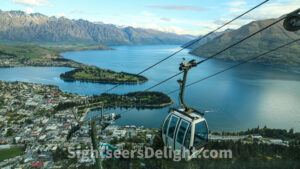The Cardrona Bra Fence in Central Otago, New Zealand, is a quirky and controversial tourist “attraction.” The “attraction” dates to sometime between Christmas 1998 and New Year 1999. Apparently, passers-by began attaching bras to a rural fence near the Cardrona Distillery. The original reason for doing so remains unknown, but the number of bras quickly grew, reaching hundreds. By early 2006, about 800 bras adorned the fence, drawing attention from far-away media sources. Although popular with visitors, the fence has sparked debate over its value as an attraction.
Queenstown Gardens contains a mixture of exotic and native trees and plants, which visitors can enjoy from the garden’s variety of trails. In addition to its flora, the gardens offer beautiful views of Lake Wakatipu, the Frankton Arm and Queenstown. The first mayor of Queenstown, James W. Robertson, and the nurseryman at the time, Mr. McConnochie, planted the first two trees, English oaks, in the gardens in 1866 to celebrate the incorporation of the borough. However, the gardens did not officially open until 1867, and significant planting started at that time.
The Skyline Queenstown gondola that takes visitors to Bob’s Peak, the prominent hill above Queenstown, part of the Ben Lomond mountain. Bus company owner Ian Hamilton had a road cut in 1961 to drive tourists to the viewpoint. Two years after Hamilton died, Jon Dumble purchased his shares and took on two business partners for Skyline Tours. The company built a chalet on Bob’s Peak that opened in January 1964. The following year, they received planning permission to build a gondola. Skyline Enterprises launched as a public company and purchased Skyline Tours. Dumble became the company’s first managing director. The gondola system opened officially on Nov. 17, 1967.
St. Peter’s was designed by an architect from Dunedin using Gothic details, but built along the lines of an English parish church. Anglican roots in Queenstown, however, date to at least 1861. An earlier church was built in 1863 and modified over the years. The oft-photographed stone church, which almost seems out of place in adreneline-driven modern Queenstown, seats 130 people.
The TSS Earnslaw, a 1912 Edwardian vintage twin-screw steamer, plies the waters of Lake Wakatipu in and around Queenstown. The vessel launched on Feb. 24, 1912, and formerly served New Zealand Railways (NZR), earning the nickname the “Lady of the Lake.” The steamer is said to be the only remaining commercial passenger-carrying coal-fired steamship in the southern hemisphere. Today, the Earnslaw carries tourist passengers across Lake Wakatipu from Queenstown to Walter Peak High Country Farm. During the 1.5-hour cruise, travelers can view the steam engine and watch stokers feed coal.
William Gilbert Rees was an explorer, surveyor and early settler in Central Otago, New Zealand, and is regarded as the founder of Queenstown. He and fellow explorer Nicholas von Tunzelmann were the first Europeans to settle the Wakatipu basin. A statue of Rees stands on Rees Street in Queenstown.








